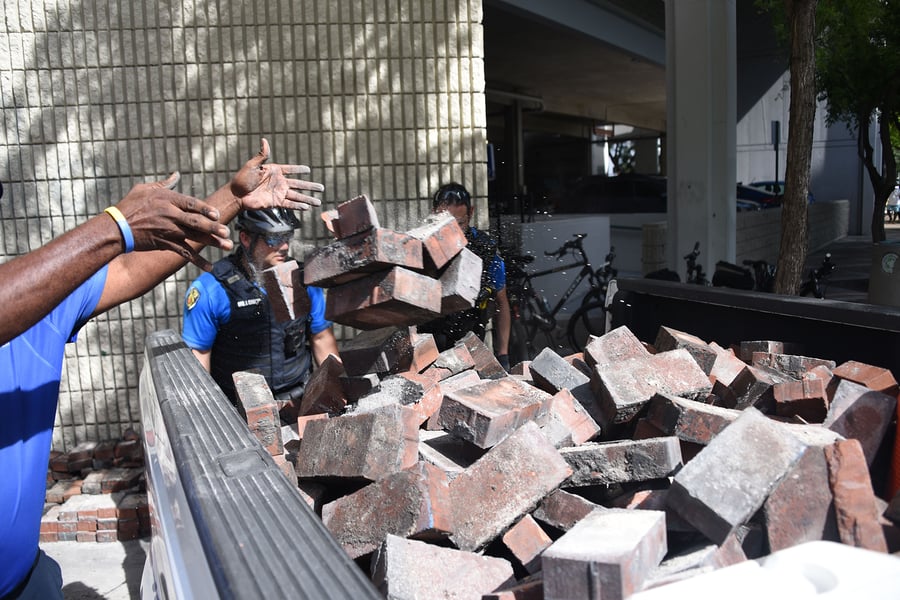A hashtag suggesting that authorities are planting bricks to bait protesters into committing violence is going viral on social media.
One image often shared with the hashtag shows a stack of bricks with a smiley face superimposed on top of it, with the message “Well howdy! I’m just a mysterious ol’ pile of bricks.”
“Do not reach for me! I am intentionally placed here to create violence,” the image, which has also made the rounds on Instagram, says. “This is used to delegitimize the movement and allows for more force to be used.” The message closes with an admonition for people to tweet photos or videos of bricks at protest sites with the hashtag #baitbricks.
On Twitter, the hashtag #baitbricks has been used more than 2,500 times as of Tuesday evening, gaining momentum within the past 24 hours, according to data shared with Rolling Stone by Darren Linvill, associate professor of communication at Clemson University. The hashtag appears to have originated from a quote tweet featuring an Instagram video posted by protester Reuben Lael, who spotted a stack of bricks outside a courthouse at a protest in Dallas on Friday, May 29th. “This right here? This is a setup,” he says in the video, which has been viewed on his Instagram nearly 100,000 times.
Another viral video circulating on Twitter purports to show police officers loading bricks onto a truck in an alley. “They’re doing that for undercover police officers getting involved in the protests so they have an excuse to beat the shit out of people,” the person recording the footage, which has accumulated millions of views, is heard saying.
The Northeastern University campus police later posted a tweet stating that the bricks came from a damaged sidewalk and were being removed due to posing a “safety hazard for pedestrians,” prompting the original poster to remove the video. But it continues to be shared across Twitter, including by some prominent far-right media personalities claiming the protests are staged and the activists are crisis actors, a narrative intended to undermine the legitimacy of the protests.
The idea that bricks are being strategically placed in protest sites to incite violence has been endorsed by police as well. On Wednesday NYPD Commissioner Dermot Shea tweeted a video of police officers next to a crate of bricks, with the caption, “This is what our cops are up against: Organized looters, strategically placing caches of bricks & rocks at locations throughout NYC.” The video, which was also promoted by conspiracy theorist Jack Posobiec, appears to have been taken in the Gravesend neighborhood of Brooklyn, where no major protests have actually taken place.
Love Music?
Get your daily dose of everything happening in Australian/New Zealand music and globally.
As the protests against the brutal killing of George Floyd have swept the entire country, misinformation and hoaxes have swirled on social media. On Monday, the hashtag #dcblackout, propagating the idea that authorities instituted a communications blackout to silence protesters in Washington, D.C., was tweeted 500,000 times in nine hours, even though it was later debunked by activists in the city and Twitter suspended hundreds of accounts that promoted it. NBC News also reported that a white supremacist organization called Identity Evropa was responsible for @ANTIFA_US, an account purporting to represent a national Antifa organization, which was later removed by Twitter for violating its rules about spam and platform manipulation.
Such attempts to sow misinformation are not uncommon when it comes to high-profile news events, says Linvill. “These are fast moving stories and conversations. There are more people on social media talking about them than normal and their rates of communication are higher. The normal places one might get information aren’t moving at the speed people are hungering for, and so [social media] is an environment where misinformation and conspiracy theories are inevitably going to spread.”
When it comes to #baitbricks, it is not immediately apparent that it’s a deliberate attempt to sow misinformation. Even though many of the accounts that initially tweeted it had relatively few followers, which can be a sign of bot activity, Joan Donovan, research director at Harvard Kennedy’s Shorenstein Center on Media, Politics and Public Policy, says it’s unlikely it’s a planted narrative, “because there is more talk about it than is just contained within the hashtag. It seems to have some degree of organic spread.”
The underlying concerns about cops infiltrating protests and encouraging violence to justify force are certainly not without merit. In cities across the country, protesters have reported that actions have been largely peaceful until officials escalated violence with tear gas or rubber bullets. Viral footage showing a man in a gas mask smashing the windows of an Auto Zone with a hammer also led protesters to accuse the man of being a police plant, an allegation the Minneapolis Police Department has denied.
Yet there is little evidence that authorities are intentionally planting bricks at protest sites to goad activists. “Often in cities there will be construction areas with bricks and other materials,” says Donovan. “I think in most instances we never notice them, but they take on new meaning during moments like this. Linvill refers to the hashtag as an “organic conspiracy theory taking place in real time.”
“A few of the images I’ve seen look completely innocent, and bricks are the sort of thing you don’t notice till you’re looking for them,” he says. “And then when you do, they’re everywhere.”



































